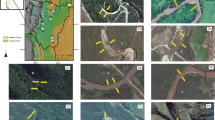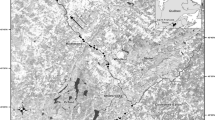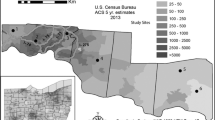Abstract
We studied riparian forests along mountain streams in four large watersheds of western Oregon and far northern California, USA, to better understand the multiscale controls on woody riparian vegetation in a geographically complex region. In each of the four-study watersheds, we sampled woody riparian vegetation in161-ha sampling reaches that straddled the stream channel. Within each hectare, we sampled riparian vegetation and local environmental factors in 40 m2 sampling plots arrayed along topographic transects. We also surveyed natural disturbance gaps in 6 ha in each watershed to explore the effects of fine scale disturbance on species distributions. We compared species composition across our study watersheds and used Nonmetric Multidimensional Scaling (NMS) and chi-squared analyses to compare the relative importance of landscape scale climate variables and local topographic and disturbance variables in explaining species distributions at sampling plot and hectare scales.
We noted substantial turnover in the riparian flora across the region, with greatest numbers of unique species in watersheds at the ends of the regional gradient. In NMS ordinations at both scales, variation in woody riparian species composition showed strongest correlations with climatic variables and Rubus spectabilis cover, but the latter was only an important factor in the two northern watersheds. At the smaller scale, topographic variables were also important. Chi-squared analyses confirmed that more species showed landscape scale habitat preferences (watershed associations) than associations with topographic position (94.7% vs. 42.7% of species tested) or gap versus forest setting (94.7% vs. 24.6% of species tested). The woody riparian flora of western Oregon shows important biogeographic variation; species distributions showed strong associations with climatic variables, which were the primary correlates of compositional change between riparian sites at both scales analyzed. Additional local variation in composition was explained by measures of topography and disturbance.






Similar content being viewed by others
References
Alcaraz F, Rios S, Inocencio C, Robledo A (1997) Variation in the riparian landscape of the Segura River Basin, SE Spain. J Veg Sci 8:597–600
Baker WL (1989) Macro and micro-scale influences on riparian vegetation in western Colorado. Ann Soc Am Geogr 79:65–78
Bendix J (1994) Among-site variation in riparian vegetation of the southern california transverse ranges. Am Midland Nat 132:136–151
Collins SL, Risser PG, Rice EL (1981) Ordination and classification of mature bottomland forests in northcentral Oklahoma. Bull Torrey Bot Club 108:152–165
Dixon MD, Turner MG, Jin C (2002) Riparian tree seedling distribution on Wisconsin River sandbars: controls at different spatial scales. Ecol Monogr 72:465–485
Dwire KA, Kauffman JB (2003) Fire and riparian ecosystems in landscapes of the western USA. For Ecol Manag 0178:61–74
Dykaar BB, Wigington PJ (2000) Floodplain formation and cottonwood colonization patterns on the Willamette River, Oregon, USA. Environ Manag 25:87–104
Everett R, Schellhaas R, Ohlson P, Spurbeck D, Keenum D (2003) Continuity in fire disturbance between riparian and adjacent sideslope Douglas-fir forests. For Ecol Manag 175:31–47
Fonda RW (1974) Forest succession in relation to river terrace development in Olympic National Park, Washington. Ecol 55:927–942
Franklin JF, Dyrness CT (1988) Natural vegetation of Oregon and Washington. USDA Forest Service General Technical Report PNW-8
Gregory SV, Swanson FJ, McKee WA, Cummins KW (1991) An ecosystem perspective of riparian zones. Biosci 41:540–551
Hack JT, Goodlet JC (1960) Geomorphology and forest ecology of a mountain region in the central Appalachians. U.S. Geological Survey Professional Paper 347,66 pp
Harris RR (1987) Occurrence of vegetation on geomorphic surfaces in the active floodplain of a Californian alluvial stream. Am Midland Nat 18:393–405
Hibbs DE, Bower AL (2001) Riparian forests of the Oregon Coast Range. Forest Ecol and Manage 154:201–213
Hickman JC (eds) (1993) The Jepson Manual, Higher Plants of California. University of California Press, Berkeley, CA, 1400 pp
Hitchcock CL, Cronquist A (1973) Flora of the Pacific northwest: an illustrated manual. University of Washington Press, Seattle, WA
Holdridge LR (1947) Determination of world plant formations from simple climate data. Science 105:367–368
Hughes FMR, Adams WM, Muller E, Nilsson C, Richards KS, Barsoum N, Decamps H, Foussadier R, Girel J, Guilloy H, Hayes A, Johansson ME, Lambs L, Pautou G, Peiry J-L, Perrow M, Vautier F, Winfield M (2001) The importance of different scale processes for the restoration of floodplain woodlands. Regulated Rivers Research and Manage 17:325–345
Hupp CR (1986) Upstream variation in bottomland vegetation patterns, northwestern Virginia. Bull Torrey Bot Club 113:421–430
Hupp CR, Osterkamp WR (1985) Bottomland vegetation distribution along Passage Creek, Virginia, in relation to fluvial landforms. Ecol 66:670–681
Johnson SL, Swanson FJ, Grant GE, Wondzell SM (2000) Riparian forest disturbances by a mountain flood- the influence of floated wood. Hydrol Proc 00:1–20
Johnson WC (1994) Woodland expansion in the Platte River, Nebraska: patterns and causes. Ecol Monogr 64:45–84
Keddy P, Shipley B (1989) Competitive hierarchies in herbaceous plant communities. Oikos 54:234–241
Kolb TE, Hart SC, Amundson R (1997) Boxelder water sources and physiology at perennial and ephemeral stream sites in Arizona. Tree Physiol 17:151–160
Kruskal JB (1964) Nonmetric multidimensional scaling: a numerical method. Psychometrika 29:115–129
Leopold LB, Wolman MG, Miller JP (1964) Fluvial processes in geomorphology: a series of books in geology. W.H. Freeman, San Francisco, 522 pp
Magurran AE (1988) Ecological diversity and its measurement. Princeton University Press, Princeton
Malmqvist B (2002) Aquatic invertebrates in riverine landscapes. Freshw Biol 47:679–694
Mather PM (1976) Computational methods of multivariate analysis in physical geography. J. Wiley and Sons, London, 532 pp
Maftsoft, Inc. (2000) SPLUS Version 6.0 for Windows
McCune B, Mefford MJ (1999) PC Ord for Windows. Multivariate analysis of ecological data, Version4.20. MJM Software, Gleneden Beach, Oregon, USA
Minore D (1979) Comparative autecological characteristics of northwestern tree species: a literature review. USDA Forest Service General Technical Report GTR-PNW-87
Minore D, Weatherly HG (1994) Riparian trees, shrubs, and forest regeneration in the coastal mountains of Oregon. New For 8:249–263
Mitsch WJ, Gosselink JG (2000) Wetlands, 3rd ed. J. Wiley & Sons, New York
Montgomery DR (1999) Process domains and the river continuum. J Am Water Resour Assoc 35:397–410
Mouw JEB, Alaback PA (2003) Putting floodplain hyperdiversity in a regional context: an assessment of terrestrial-floodplain connectivity in a montane environment. J Biogeogr 30:87–103
Naiman RJ, Bilby RE, Bisson PA, (2000) Riparian ecology and management in the Pacific coastal rainforest. BioSci 50:996–1011
Nierenberg T, Hibbs DE (2000) A characterization of unmanaged riparian areas in the central Coast Range of western Oregon. For Ecol Manag 129:195–206
Pabst RJ, Spies T (1998) Distribution of herbs and shrubs in relation to landform and canopy cover in riparian forests of coastal Oregon. Can J Bot 76:298–315
Pabst RJ, Spies TA (1999) Structure and composition of unmanaged riparian forests in the coastal mountains of Oregon, U.S.A. Can J For Res 29:1557–1573
Patten DT (1998) Riparian ecosystems of semi-arid North America: diversity and human impacts. Wetlands 18(4):498–512
Robertson KM, Augsberger CK (1999) Geomorphic processes and spatial patterns of primary forest succession on the Bogue Chitto River, USA. J Ecol 87(6):1052–1063
Running SW, Nemani RR, Hungerford RD (1987) Extrapolation of synoptic meteorological data in mountainous terrain and its use for simulating forest evapotranspiration and photosynthesis. Can J For Res 17:472–483
Saab V (1999) Importance of spatial scale to habitat use by breeding birds in riparian forests: a hierarchical analysis. Ecol Appl 9:135–151
Sakai T, Hiroshi T, Suzuki W, Nomuya H, Kanazashi T, Iida S, Nakashizuka T (1999) Riparian disturbance and community structure of a Quercus-Ulmus forest in central Japan. Plant Ecol 140:99–109
Shin N, Nakamura F (2005) Effects of fluvial geomorphology on riparian tree species in Rekifune river, northern Japan. Plant Ecol 178:15–28
Tabacchi E, Planty-Tabacchi AM, Salinas MJ, Decamps H (1996) Landscape structure and diversity in riparian plant communities: a longitudinal comparative study. Regul Rivers: Res and Manage 12:367–390
Tappeiner JC, Zasada JC, Ryan P, Newton M (1991) Salmonberry clonal and population structure, the basis of a persistent cover. Ecol 72:609–618
Thornton PE, Running SW, White MA (1997) Generating surfaces of daily meteorological variables over large regions of complex terrain. J Hydrol 190:214–251
Walter H (1973) Vegetation of the earth in relation to the eco-physiological conditions. Springer-Verlag, New York
Waring RH, Major J (1964) Some vegetation of the California coastal redwood region in relation to gradients of moisture, nutrients, light and temperature. Ecol Monogr 34:167–215
Waring RH, Coops NC, Ohmann JL, Sarr DA (2002) Interpreting woody plant richness from seasonal ratios of photosynthesis. Ecol 83:2964–2970
Acknowledgements
Earlier versions of this manuscript were greatly improved by comments from Dominique Bachelet, Mary Kentula, Jeff Shatford, Rob Pabst, Richard Waring, and Jim Wigington, of Oregon State University, David Cooper of Colorado State University, and two anonymous reviewers. Support for this research was provided by the Cooperative Forest Ecosystem Research Program at Oregon State University, Corvallis, USA.
Author information
Authors and Affiliations
Corresponding author
Appendix
Appendix
Rights and permissions
About this article
Cite this article
Sarr, D.A., Hibbs, D.E. Woody riparian plant distributions in western Oregon, USA: comparing landscape and local scale factors. Plant Ecol 190, 291–311 (2007). https://doi.org/10.1007/s11258-006-9208-2
Received:
Accepted:
Published:
Issue Date:
DOI: https://doi.org/10.1007/s11258-006-9208-2




